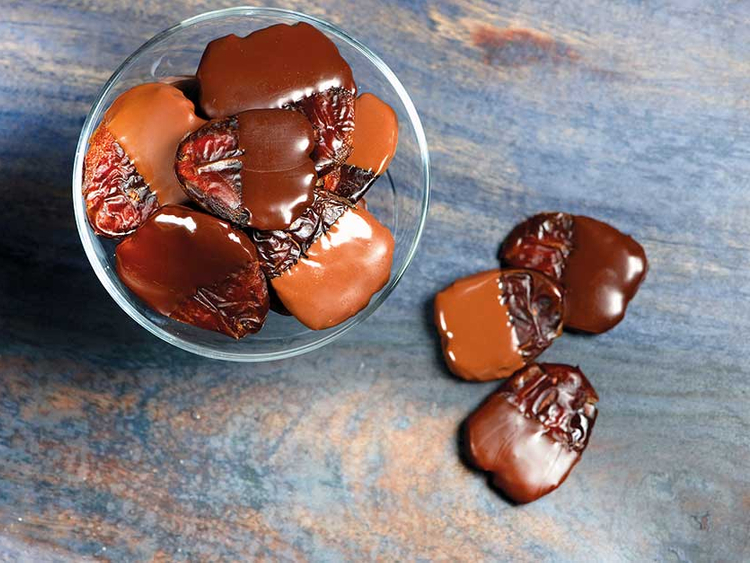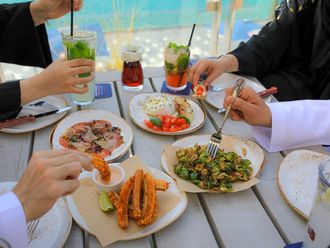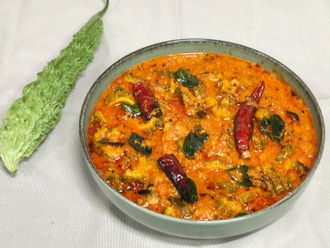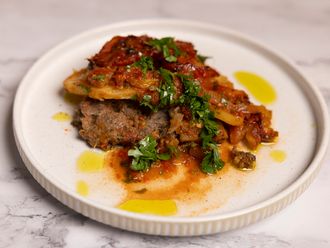
Anyone who’s lived in the Middle East for a reasonable length of time will tell you how they’ve struggled to find fresh seasonal produce over the summer. Supermarkets offer little beyond okra, aubergines, tomatoes and cucumbers — except in August, when the produce aisles practically heave with freshly harvested dates.
Hanging in giant bunches from palms on highways and outside villas all around the country, these little flavour bombs are in season now, allowing locavores and eco warriors to see if they can truly stomach their beliefs. But although dried dates are a regional staple, ubiquitous in Ramadan and at hotel lobbies across the country all year round, the freshly harvested fruit is less widely seen and consumed.
Which is a shame, because apart from their street cred, fresh dates are incredibly versatile. Sadly, you wouldn’t know that going by restaurant menus across the country (except for raw or paleo concepts). Even some UAE-based chefs we’ve spoken to previously are unable to go beyond basic ideas, and often confuse the fresh and dried fruit. Or maybe few people can muster up excitement about dates outside Ramadan.
Most chefs we spoke to insist that dates are best eaten on their own with a cup of thick qahwa, or Arabic coffee, in the Emirati tradition, to cut the sweetness.
EMIRATI STAPLE
Besides their obvious use in desserts, fresh dates pair well with citrus flavours, particularly lemon and grapefruit, as well as with game meat, says Ricardo Menta, head chef at Thanani restaurant on the Ajman corniche.
“Fresh dates are great for most dishes as they have a wonderful flavour, add richness and depth, and are easily adaptable to most recipes. Dried dates, on the other hand, are great in home-made granola or traditional drinks as they add sweetness and are softer and easier to eat,” he explains.
Dates have been part of the region’s diet for more than 7,000 years and have always been considered a nourishing supplement, Menta adds. The traditional pairing with camel milk delivers a barrage of nutrients, he explains: dates have no fat and are rich in vitamins A, B and D, while camel milk is replete with vitamin C and fat.
“Emiratis traditionally baked dates, or used them in purees, pastes and dips,” says Chef Jean Luc of Cafe Bateel, who recommends adding them to salads, or combining them with other ingredients in simple dips and appetisers, besides their obvious use in desserts.
These date syrups work beautifully with local breads such as raqa, khameer and chebab, and, as in Europe, when paired with cheese, says KA Athula Kumara, Sous chef at Rare restaurant, over at Desert Palm resort. “Or you could have fresh dates as a side with a traditional bowl of Harira Soup.”
Dates also work well in stews with chicken or beef, although the best known use is in a rich Moroccan tagine.
“When simmered together with the lamb and the sauce, the dates add a taste that is so rich and flavourful you will be happy to eat the sauce alone,” says Chef Doxis Bekris, director of food & beverage and culinary operations at Raffles Dubai. “Fresh dates that are further along in their ripening process they work well in salads with sour dressings made from lemon or vinegar, as do dried dates, as this balances the sweet taste of the dates and creates a sweet and sour umami flavour that will have you enjoying every last bite.”
Jiju Paul, executive sous chef at the Fairmont Ajman, reveals his hotel is rolling out a series of new dishes incorporating dates this fall. “This is our way of providing an authentic dining experience incorporating local essence and flavour in a true reflection of the destination we’re operating in. For instance, date and smoked tomato jam will be served in Xolo bar as a condiment for burgers; guests can discover the new date cheesecakes at Azrak, date granola will be offered at Spectrum, and balsamic chutney with dates and foie gras in Gioia, just to name a few,” he says.
And over at the Ritz-Carlton DIFC, executive sous chef Muhannad Al Ateem, tosses dates into a kale salad that’s on the menu at Cake restaurant. “We serve this dish because many people started asking for kale salad. We added Medjool dates to balance the sweetness and bitterness of the kale leaves,” he says. He adds walnuts, halloumi and tosses the lot in a balsamic dressing before finishing with pomegranate seeds.
His other winning combination is with potato and spinach gnocchi, which is both comforting and healthy.
BUYING DATES
So how do you go about choosing fresh dates? How can you tell if they’re ripe in a blind tasting? Can you use green dates plucked off the neighbour’s tree?
“A rule of thumb is that if they’re bitter and dry in texture, they’re raw,” says Alateem. “It has been proven that the longer you leave the dates hanging on the tree to ripe, you will have a better result in taste. It is like ageing.”
When buying dates, look for soft fruit with a bright, glossy skin, recommends Atul Kumar, Sous Chef at the Four Points by Sheraton, Bur Dubai. “Touch the dates to make sure they are soft. Watch out for dates that are too sticky, as they are not fresh. And if there’s any crystallised sugar or mould on the skin.” He suggests looking for dates that look plump and glossy.
Taste is another indicator. Fresh dates have a crunchy apple-like texture and are sweet like honey while dried dates are chewier and caramel-like, says Paul.
Although there are more than 50 cultivars grown across the Middle East, North Africa and South Asia (Medjool and Khidri being perhaps the most famous), all varieties go through five distinct stages of maturity, spanning about seven months. In the earliest stages, hababauk and khimri, the fruit is green and small and considered inedible. By the khalal stage, about four months after pollination, the fruit changes colour to yellow, pink or red (depending on the variety). It’s about 50 per cent water, and has a high tannin content, with a bitter or astringent taste. At this point, you’d want to freeze them for a few weeks before use, or pickle them with vinegar, lemon and olive oil.
By the Rutab stage, another six weeks later, the tannins have begun to break down and the sweetness sets in. By this time the fruit is still a little soft, and is chewy in texture with a strong caramel flavour. “At the Rutab stage, dates can be used in juices such as jallab, a popular local fruit syrup, or for a preparing a kompot, a kind of fruit punch. Rutab stage dates are particularly primed for using in ice cream,” says Paul.
Most people are only familiar with the final Tamar stage, by which time dates are a bit mushy, like a banana that’s just past its peak, although they’re fairly dry by now.
The high concentration of sugar means they store well, but dates at different stages require different storage methods.
“The best method I have found to preserve fresh dates for longer, is to wrap them in non-absorbent paper and place them in the freezer — when you want to eat one just defrost at room temperature for five to seven minutes,” says Bekris. As for dried dates, popping them in a dark airtight container away from heat and sunlight is enough. “Both can dry out your dates and affect their taste and quality.” And nobody wants a dry date.
SUGARY TREATS WITH HEALTH BENEFITS
Whether fresh or dried, dates are a nutritional powerhouse suitable for diabetics and those with cardiovascular disease.
They’re high in fibre, antioxidants and minerals such as iron, calcium, manganese and potassium, says Achira Danushka, pastry chef at Dubai International Hotel. She echoes pronouncements from the American Heart Association, which says Mejdool dates in particular make dates an ideal sugar substitute in recipes and a heart-healthy snack.
Ishi Khosla, a clinical nutritionist with Weightmonitor UAE agrees that the rich natural sugars in dates allow diabetics to occasionally indulge a sweet tooth. “Dates are certainly a great substitute to sugars for diabetics and heart patients. In fact dates are better than sugar as they contain fibre. When we combine carbohydrates with fats, fibre or protein rich foods, it slows the absorption of sugars and helps blood sugar management,” she says.
And the science bears out the chefs, it seems. “Fresh dates, when combined with Vitamin C-rich foods like berries, citrus fruits or lemon, help enhance maximum absorption of nutrients. You can start your day on a healthy note by combining dates with milk,” Khosla says.
Seared Foie Grass with Date & Balsamic Chutney
Courtesy Chef Jiju Paul, Fairmont Ajman
Serves — 2
Ingredients
120g Foie grass
3 slices brioche bread, trimmed
1 red apple, peeled and diced
3-4 raspberries
50ml raspberry puree
150g sugar
5ml raspberry vinegar
5ml saffron water
1/3 tsp ground cinnamon
2 sprigs thyme
1 lemon
20g unsalted butter
Date & Balsamic chutney
500g dates
50ml olive oil
3 cloves garlic, chopped
300g red onions, chopped
30g sweet red bell peppers, chopped
30ml red vinegar
150g sugar
50ml Balsamic vinegar
Salt, as desired
METHOD
• Season the foie gras with salt and pepper and set aside in the chiller until required.
• For the braised apples, caramelise 80g of sugar in a skillet. Add the apples, sprigs of thyme, butter and saffron water and simmer until cooked.
• For the date and balsamic chutney, Place the dates in a pot containing one litre of water and boil until soft. Remove and deseed.
• In a pan, add oil, garlic, onion and peppers and cook until the mixture is translucent. Add in the red vinegar and sugar and continue cooking until soft. Strain the excess liquid and add the deseeded dates. Stir, then add the balsamic vinegar and allow the mixture to reduce to a jam-like consistency. Taste and add salt to your liking.
• Make the raspberry jus by adding half the raspberry vinegar and 50g of sugar to a pan. Bring to a boil and simmer until the mixture is reduced to a thick glaze.
• In another pan, warm the remaining vinegar, add the fresh raspberries and glaze.
• To assemble, pre-heat a grill pan, and cook the foie grass (about one minute on each side), remove from heat and plate as desired, with garnish of choice.


















